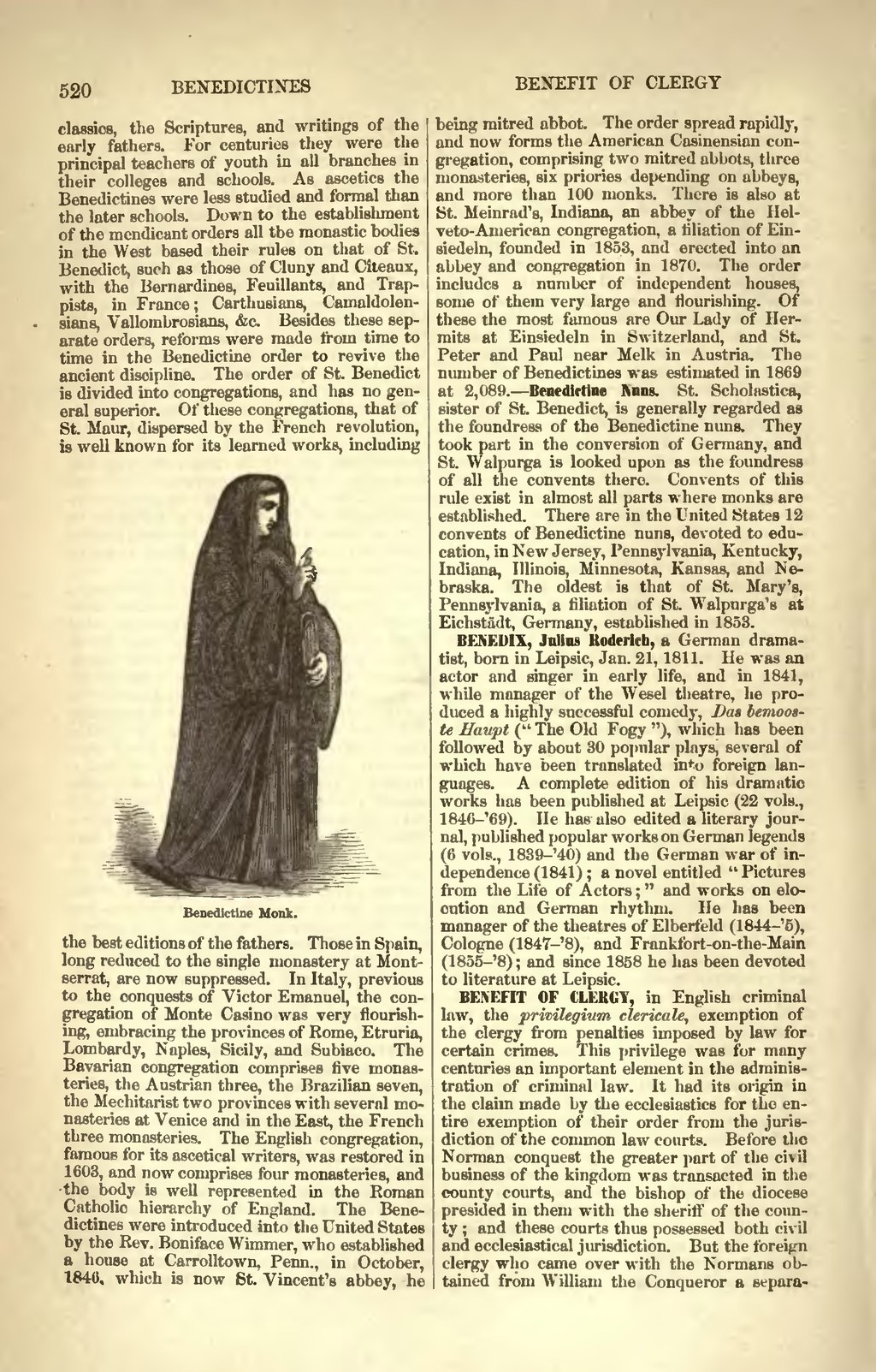520 BENEDICTINES classics, the Scriptures, and writings of the early fathers. For centuries they were the principal teachers of youth in all branches in their colleges and schools. As ascetics the Benedictines were less studied and formal than the later schools. Down to the establishment of the mendicant orders all the monastic bodies in the West based their rules on that of St. Benedict, such as those of Cluny and Citeaux, with the Bernardines, Feuillants, and Trap- pists, in France ; Carthusians, Camaldolen- sians, Vallombrosians, &c. Besides these sep- arate orders, reforms were made from time to time in the Benedictine order to revive the ancient discipline. The order of St. Benedict is divided into congregations, and has no gen- eral superior. Of these congregations, that of St. Maur, dispersed by the French revolution, is well known for its learned works, including Benedictine Monk. the best editions of the fathers. Those in Spain, long reduced to the single monastery at Mont- serrat, are now suppressed. In Italy, previous to the conquests of Victor Emanuel, the con- gregation of Monte Casino was very flourish- ing, embracing the provinces of Rome, Etruria, Lombardy, Naples, Sicily, and Subiaco. The Bavarian congregation comprises five monas- teries, the Austrian three, the Brazilian seven, the Mechitarist two provinces with several mo- nasteries at Venice and in the East, the French three monasteries. The English congregation, famous for its ascetical writers, was restored in 1603, and now comprises four monasteries, and the body is well represented in the Roman Catholic hierarchy of England. The Bene- dictines were introduced into the United States by the Rev. Boniface Wimmer, who established a house at Carrolltown, Penn., in October, T84G, which is now St. Vincent's abbey, he BENEFIT OF CLERGY being mitred abbot. The order spread rapidly, and now forms the American Casinensian con- gregation, comprising two mitred abbots, three monasteries, six priories depending on abbeys, and more than 100 monks. There is also at St. Meinrad's, Indiana, an abbey of the Ilel- veto-American congregation, a filiation of Ein- siedeln, founded in 1853, and erected into an abbey and congregation in 1870. The order includes a number of independent houses, some of them very large and flourishing. Of these the most famous are Our Lady of Her- mits at Einsiedeln in Switzerland, and St. Peter and Paul near Melk in Austria. The number of Benedictines was estimated in 1869 at 2,089. Benedictine Nuns. St. Scholastica, sister of St. Benedict, is generally regarded as the foundress of the Benedictine nuns. They took part in the conversion of Germany, and St. Walpurga is looked upon as the foundress of all the convents there. Convents of this rule exist in almost all parts where monks are established. There are in the United States 12 convents of Benedictine nuns, devoted to edu- cation, in New Jersey, Pennsylvania, Kentucky, Indiana, Illinois, Minnesota, Kansas, and Ne- braska. The oldest is that of St. Mary's, Pennsylvania, a filiation of St. Walpurga's at Eichstadt, Germany, established in 1853. IM:M:DI. Julius Koderich, a German drama- tist, born in Leipsic, Jan. 21, 1811. He was an actor and singer in early life, and in 1841, while manager of the Wesel theatre, he pro- duced a highly successful comedy, Dai lemoos- te Haupt (" The Old Fogy "), which has been followed by about 30 popular plays^ several of which have been translated into foreign lan- guages. A complete edition of his dramatic works has been published at Leipsic (22 vols., 1846-'69). lie has also edited a literary jour- nal, published popular works on German legends (6 vols., 1839-'40) and the German war of in- dependence (1841) ; a novel entitled "Pictures from the Life of Actors ; " and works on elo- cution and German rhythm. He has been manager of the theatres of Elberfeld (1844-'5), Cologne (1847-'8), and Frankfort-on-the-Main (1855-'8); and since 1858 he has been devoted to literature at Leipsic. BENEFIT OF CLERGY, in English criminal law, the prmlegium clericals, exemption of the clergy from penalties imposed by law for certain crimes. This privilege was for many centuries an important element in the adminis- tration of criminal law. It had its origin in the claim made by the ecclesiastics for the en- tire exemption of their order from the juris- diction of the common law courts. Before the Norman conquest the greater part of the civil business of the kingdom was transacted in the county courts, and the bishop of the diocese presided in them with the sheriff of the coun- ty ; and these courts thus possessed both civil and ecclesiastical jurisdiction. But the foreign clergy who came over with the Normans ob- tained from William the Conqueror a separa-
